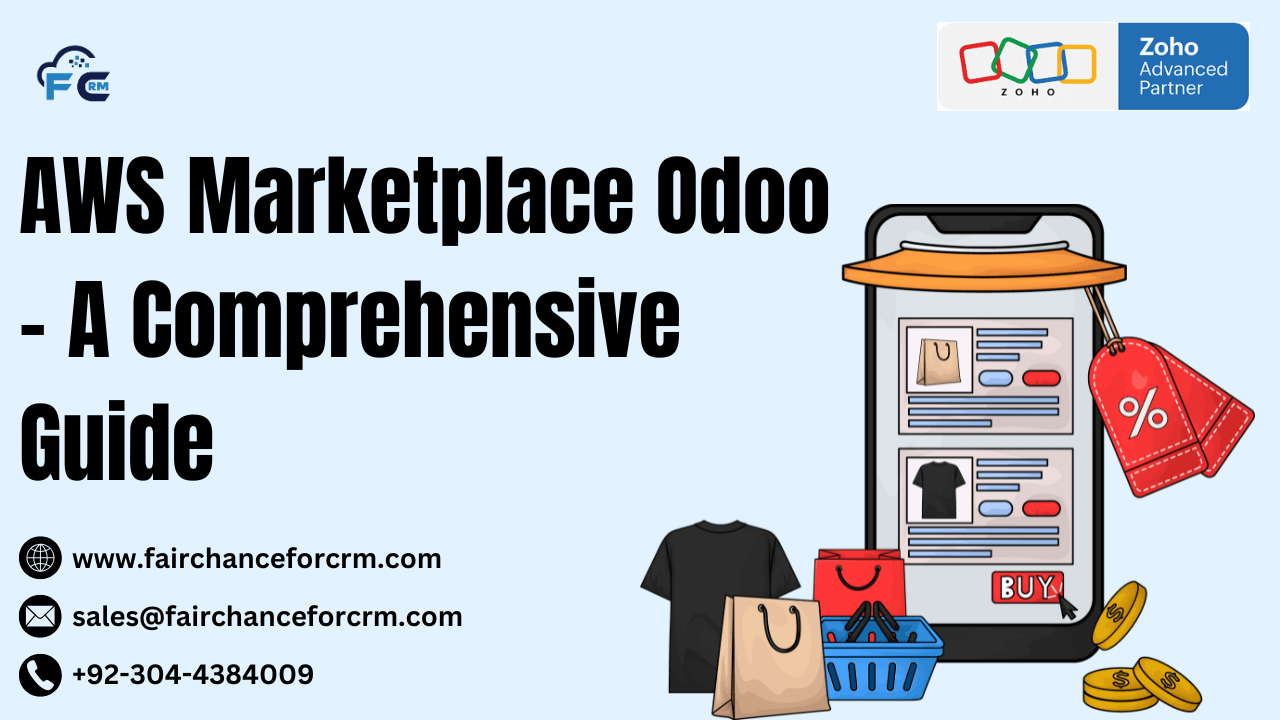AWS Marketplace Odoo, one of the most popular open-source ERP (Enterprise Resource Planning) systems, has been widely adopted by businesses to streamline operations, integrate business functions, and automate processes. AWS (Amazon Web Services) Marketplace now offers Odoo as a solution for businesses looking to deploy Odoo on the cloud, providing an easy and efficient way to get started with Odoo without the complexities of managing the infrastructure.
In this article, we will explore the features of Odoo available on AWS Marketplace, how to deploy Odoo using AWS, and include some common FAQs along with code examples for integration.
Also Read:
- Automated Email Campaigns in Zoho CRM for E-Commerce Business
- 7 Reasons Zoho CRM is the Best Choice for E-Commerce
- Ecommerce Operations 101: Essentials of Running a Profitable Online Store
- The Ultimate Guide to Ecommerce Marketing | FAIRCHANCE FOR CRM
- 9 Challenges for Ecommerce Businesses and How to Improve
What is AWS Marketplace Odoo?
AWS Marketplace is an online store that helps users find, test, and buy software that runs on Amazon Web Services (AWS). With Odoo listed on AWS Marketplace, businesses can now quickly deploy the Odoo ERP software on AWS’s highly scalable, reliable, and secure cloud infrastructure.
The AWS Marketplace for Odoo offers the following advantages:
- Quick Deployment: You can instantly launch an Odoo instance with a few clicks, without worrying about the underlying infrastructure.
- Scalability: As your business grows, you can scale your Odoo environment on AWS without the hassle of server management.
- Security: AWS provides robust security features, including encryption, access control, and compliance with industry standards.
- Managed Backup and Monitoring: AWS offers integrated backup solutions and cloud monitoring, ensuring the reliability and availability of your Odoo system.
How to Deploy Odoo on AWS Marketplace?
Deploying Odoo from AWS Marketplace is relatively simple. Here’s a step-by-step guide to getting Odoo up and running:
Step 1: Access AWS Marketplace
- Go to AWS Marketplace.
- Search for “Odoo” in the search bar.
- Select the Odoo version that fits your business needs (Community or Enterprise).
Step 2: Select Your Odoo Version
There are various configurations of Odoo available for deployment. Choose between:
- Odoo Community Edition: The open-source, free version with core ERP functionalities.
- Odoo Enterprise Edition: A paid version with advanced features such as custom apps, additional reports, and mobile support.
Make sure to choose the correct version based on your organization’s needs.
Step 3: Launch the Odoo Instance
- Click the “Continue to Subscribe” button after selecting your desired Odoo edition.
- Choose the region where you want to deploy your Odoo instance.
- Select the instance type (e.g., t2.medium, t3.small) depending on your expected traffic and performance needs.
- Click “Launch with EC2” to start the deployment process.
AWS will automatically provision the necessary infrastructure, configure Odoo, and allow you to access the instance via an IP address.
Step 4: Set Up Odoo
Once your Odoo instance is up and running, you can access the Odoo web interface by navigating to the public IP address in your browser.
- Configure Basic Settings: Set up your company details, create user accounts, and configure modules (e.g., Sales, Accounting, Inventory).
- Install Additional Modules: AWS Marketplace Odoo instances often come with a set of pre-installed modules, but you can install additional ones from the Odoo App Store.
Code Examples for AWS Integration with Odoo
While AWS Marketplace allows for a quick deployment of Odoo on the cloud, there may be times when you need to integrate Odoo with other AWS services or extend Odoo’s capabilities. Below are some examples of integrating Odoo with other AWS services, such as using AWS S3 for file storage or connecting Odoo to AWS Lambda for serverless functions.
Example 1: Integrating Odoo with AWS S3 for File Storage
You may wish to use Amazon S3 to store Odoo attachments (like invoices, documents, images) instead of keeping them on local storage. Below is an example of how you can configure this:
- Install
boto3(AWS SDK for Python): To communicate with AWS S3, you will need to installboto3in your Odoo environment. - Set up AWS credentials: Ensure that your AWS credentials (Access Key ID, Secret Access Key) are available to your Odoo instance. You can either configure them through the AWS CLI or environment variables.
- Odoo Configuration: Edit the
odoo.conffile to configure the S3 integration: - Modify Odoo to Use S3: You will need to modify Odoo’s attachment storage mechanism to point to AWS S3. There are community modules available for this, such as
odoo-s3-storage, which can be installed to configure S3 as the file storage back-end.
Example 2: Triggering AWS Lambda from Odoo
You may want to invoke an AWS Lambda function based on certain actions in Odoo, such as when an invoice is confirmed or a sale is made.
- Create an AWS Lambda Function: Write a Lambda function that processes some data when triggered. For example:
- Create an API Gateway for Lambda: Create an API Gateway to expose your Lambda function via HTTP.
- Trigger Lambda from Odoo: Use the
requestslibrary in Python to send a HTTP request to the API Gateway endpoint: - Link with Odoo Event: Call the
trigger_lambda()function whenever a specific event occurs in Odoo, such as when an invoice is confirmed.
FAQs about AWS Marketplace Odoo
- What is the cost of AWS Marketplace Odoo? The pricing for Odoo on AWS Marketplace depends on the chosen version (Community or Enterprise), instance size, and usage. Odoo’s Community Edition is free, but the Enterprise Edition involves a subscription cost. AWS will charge based on the EC2 instance type, storage, and data transfer.
- Can I upgrade from Odoo Community to Odoo Enterprise on AWS Marketplace? Yes, you can upgrade your Odoo Community edition to the Enterprise edition by following Odoo’s official upgrade path. The upgrade requires purchasing an Enterprise subscription from Odoo and modifying the instance to include Enterprise-specific features.
- What is the difference between Odoo Community and Odoo Enterprise?
- Community: The open-source version with core ERP features. It’s free to use but lacks some advanced functionalities like mobile support, reporting, and additional enterprise-level features.
- Enterprise: A paid version that includes additional features such as more advanced reporting, full mobile app support, extra security options, and performance optimizations.
- How do I manage backups for Odoo on AWS? AWS offers multiple backup solutions, including automated snapshots and Amazon S3 for data storage. You can configure automated backups via AWS Backup or through custom scripts that back up your Odoo data regularly.
- How can I monitor Odoo’s performance on AWS? AWS CloudWatch can be used to monitor the health and performance of your Odoo instance. You can track metrics like CPU usage, memory, disk space, and network performance, and set up alarms to notify you of issues.
Conclusion
AWS Marketplace Odoo provides businesses with a seamless and scalable solution to manage their enterprise operations. By leveraging AWS’s cloud infrastructure, companies can easily deploy, maintain, and scale their Odoo instances while benefiting from enhanced security and performance monitoring. Through various integrations and customization options, businesses can further enhance Odoo’s functionality, creating a tailored ERP system that suits their specific needs.
By understanding how to deploy, configure, and integrate Odoo with AWS services, organizations can effectively leverage the power of cloud computing to streamline their operations and grow their business.
For more information about the AWS Marketplace Odoo, visit this link.
If you want to Free Trail Zoho, click on this link.




